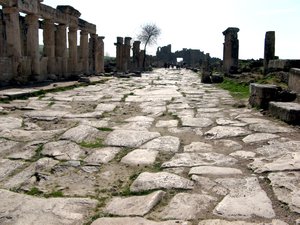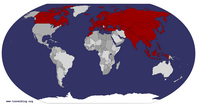Advertisement
Published: March 2nd 2010

 Heirapolis
Heirapolis
Through the ancient cityI know this is a travel blog, but I am not entirely comfortable with it simply being a list of places visited and sites seen. Really, the best part of travel are the things that happen along the way to those sites or simply absorbing the day to day life of the place you have immersed yourself in.
So on that note, let me start this entry with some thoughts on our experiences/impressions of Turkey so far. The people we have come into contact with are passionately proud of their country and its history, and are anxious to share this passion. A passing comment on the beauty of the countryside generated a heartfelt thanks in response from a beaming citizen. It is also a very family-oriented society that loooves children, and one that looks out for its neighbours and those less fortunate. It seems to me that it is a truly kind and gentle place that lives the Islam faith in practice.
An example: at the sites we have visited in the country as well as in the city, we have seen many cats and dogs just lounging and relaxing. These are clearly not family pets, yet are extremely
well fed, clean and cared for - each has a tag on its ear indicating that it has been given all required shots for instance. They do not cower when folks come near, but instead respond with happiness and a wagging tail. As we wandered Heiropolis we were accompanied by a young well fed dog who we were told was watching out for us and taking care of us as we explored. This is so completely different from my experience in Morocco where it is an extremely difficult life for animals and they are usually emaciated and sick or dying on the streets. Even mules are worked almost to death there, but here all are cared for. A number of times we have seen a small restaurant/vendor prepare food for the neighbourhood critters - and at no time have I seen dogs begging as the do here in North America (or even bark!).
Another example: we were waiting on a delayed flight, with a group that included what appeared to be professors and respected educators. One of the passengers was a mother with a young girl of perhaps 13 months who was getting restless - and one of the
senior professors walked over and took the child from the mother to give her a break. No one batted an eye, yet it was clear he did not know the mother/child - this is just what you do in Turkey - and it is hard to know who had more fun: the young child or the elder professor.
This is a tolerant society as well. There are right wing folks where ever you go, and yes they are here as well. But in a country of this size (population) where there are folks of every faith and belief, there is remarkably little confrontation. There are political concerns at the moment - fears that the current government is not secular enough and is being controlled by Islamic groups; fears that at any time the country could find itself a non-secular state restricting rights and opportunities for women for instance. There are concerns over this government and freedom of the judiciary and media. This is a critical time in Turkish history, and I wish these gentle and extremely kind people continued peaceful days ahead.
All of this is not to say that being a traveller in Turkey is always easy!

 Heirapolis
Heirapolis
SarcophagusAlways someone is trying to strike up a conversation with the objective of selling you something. "are you lost?" "where are you from?" "I just want to ask you one question" and when you walk on without response or brushing them off "you are breaking my heart". This is the challenge for me: to be open to people without being a target of touts. When to walk away and when to converse. More difficult in the city than the country, but a challenge nevertheless. I wonder how many serendipitous connections have not been made as a result of trying to manage this fine balance.
Anyway, back to travel! This trip of mine has been pretty steady going, but the time in Turkey particularly so. We mapped out an itinerary that included a few days in Istanbul, then heading south to the Aegean region and back up to Troy and Gallipoli before finishing with another couple of days in Istanbul. I have added a map with our route roughly highlighted so you can get a sense of where we are.
So early on the 18th we flew (yes, another seat sale!😊) from Istanbul to Denizli so that we could
visit Hierapolis (and Pamukkale), drive across to visit the ancient city of Aphrodisias on the 19th, and spend the 20th exploring Ephesus in the Selcuk area. Now when I was planning this the world kept telling me I was crazy, that winter was not the time to go to Turkey - it would be cold and rainy. By cold they meant 10 degrees celsius, which is spring where I am from so we kept planning. And we totally lucked out by the way - it was sunny and 20 to 25 degrees the entire time we were in the Aegean and I don't think it got below 15 degrees wherever we were. (When we first arrived in Istanbul our hotel temp was set to 31 (!!) and we had the air con on in no time. They thought it was pretty funny - they were in hats and scarves, and we were tying our jackets around our waists and worrying about sunburn). But back to the challenge: since it is off season, many inns etc close to do renovations etc in preparation for high season, and often transport is challenging between these smaller centres. So we got ourselves a guide

 Heirapolis
Heirapolis
The Roman influence: their archeswith car for this 3 day period and let her arrange our accommodation (see? I am not a complete control freak).
It turned out to be a brilliant move. I cannot imagine we would have gotten as much out of these sites without her, and certainly would have lost much time waiting on buses for transport. Fatma is 58, very educated and passionate about the history of her country, and probably could write a book about her own life story! I don't think she or us knew what to expect but it did not take long to break the ice and we felt like we were simply travelling with a (very knowledgeable) friend! She met us at the airport and was giving a bit of historical timeline overview while we drove to set the context for the next few days - me, I was admiring the view and wondering what crops were growing, and what the local energy source was ....so I was smiling politely and nodding on occasion. We must have been too quiet so she decided to engage my son by asking him an obscure question about ancient Samarian history or some such thing - and of
course, if you know anything about my son, you know he is a history buff and the guy you want on your team for any trivial pursuit tourney - so he knew the answer and she was over the moon. How did you know that !??! And they were off and running - she was, I think, very thankful to have an audience who understood and knew a few things. In Turkey, you apply to become a guide and there is a very intense screening process (with few selected) after which you study archaeology and history etc etc and take regular upgrading. So this is serious stuff and let me tell you, she was fully prepared to cram thousands of years of history into us in three days.
But we survived and had a great time with her. We started at the necropolis at Hierapolis and spent the night at Pamukkale. I don't know what I was expecting, but I was completely blown away by Hierapolis where folks came to use the supposed healing thermal waters (and when those didn't work, were buried in the necropolis). The necropolis holds over 12000 graves from a variety of backgrounds, and we
walked through there to the ancient village remains and eventually on to Pamukkale and the calcified terraces (not a fan of Pamukkale, but Hierapolis is certainly worth the visit). It was magic, perhaps because it was our first exposure to these ruins. Hierapolis ruins are pretty much from the Roman Empire, but there is evidence of the site being occupied dating back to the 5th century BC.
We also visited a local weaver and saw some wonderful textiles; also an 'onyx' place where they carve and polish rock materials into various items.
We stayed at a pretty grim place that night - because Pamukkale is extremely small and not much was open. But it did have a thermal pool and if you did not think too much about the hygiene of the place you could manage sitting in it for a bit.
Next morning we were off to Aphrodisias, the ancient city dedicated to Aphrodite and very well preserved since it was only discovered 40 years ago (meaning that things have not been pillaged and removed). These recent excavations have taken place in a time of laws prohibiting removal of artifacts. Only about half the site has

 Pamukkale
Pamukkale
Calcified terracesbeen excavated, and most of what is seen today is from the 1st and 2nd centuries AD, but archaeological evidence shows that the dedication to Aprhodite here followed a long history of worshipping goddesses like the Anatolian mother goddess and the Babylonian god Ishtar. The theater and stadium were breathtaking.
The city was granted autonomy by the Roman Empire in the late 1st century BC and prospered as a centre for religious, arts, and literature to 1st century AD. Trying to impose Christianity on the citizens was difficult though, because of Aphrodite's large following. One way to remove remnants of paganism ws to rename the city - Stavropolous (City of the Cross) during the Byzantine era (and some statues were defaced during that time). The Temple of Aphrodite is very much in ruin likely because it had lots of Pagan linkages. We also toured the museum there which holds many of the statues, sarcophogi and treasures uncovered on the site. Fragments and statues with signatures of Aphrodisian artists have apparently shown up as far away as Greece and Italy.
That afternoon we drove on to Selcuk, stopping at a ceramic centre where Iznik tiles and pottery are still
made. If you look at the photos on the Topkapi entry here you will see many tile samples - these are all Iznik tiles and hundreds and hundreds of years old. Iznik ceramics are made with quartz, and the glazing includes quartz, so it is extremely durable. It is also hand thrown and painted and is exquisite. And expensive. But oh so beautiful. We saw pottery being made and hand painting being done.
Off to our accommodation with a stop to pickup fresh local mandarins and strawberries from a street vendor. We are staying at a swanky place on the beach between Selcuk and Kusadasi - it is spotless and has a tub!
Advertisement
Tot: 0.285s; Tpl: 0.013s; cc: 11; qc: 61; dbt: 0.0694s; 1; m:domysql w:travelblog (10.17.0.13); sld: 1;
; mem: 1.2mb
















